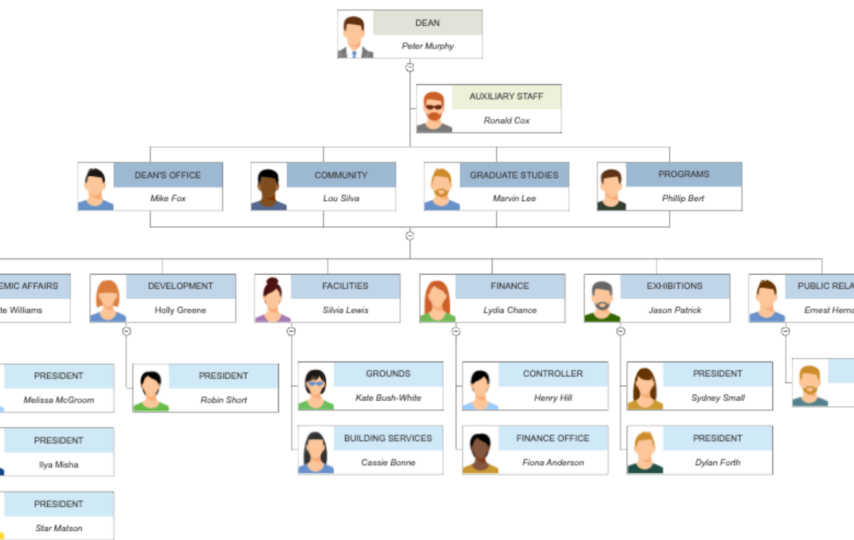Starting a new business venture can be an exhilarating and challenging experience. In the early stages, startup founders often find themselves wearing multiple hats, juggling various responsibilities, and making critical decisions on the fly. While this level of flexibility and agility is necessary, as a startup begins to grow, it becomes increasingly important to establish a clear organizational structure.
This is where organizational charts play a crucial role. In this article, we will explore why organizational charts are essential for startups and how they contribute to their success.
Defining Roles and Better Collaboration Recognition
First and foremost, organizational charts provide clarity and define roles and responsibilities within a startup. When a company is in its infancy, everyone may be involved in every aspect of the business, blurring the lines between different functions. However, as the startup scales and more employees come onboard, it becomes imperative to establish clear reporting lines and delineate areas of responsibility. Organizational charts, created by an org chart maker, visually depict the hierarchical structure of the company, outlining the different departments, teams, and their respective positions. This clarity helps employees understand their roles, responsibilities, and who they report to, fostering a sense of order and direction.
A well-designed organizational chart also facilitates effective communication and collaboration. Startups thrive on innovation and the ability to respond quickly to market demands. However, without a clear organizational structure, communication can become fragmented and inefficient.
An organizational chart ensures that information flows through the appropriate channels, reducing the likelihood of misunderstandings and miscommunication. When employees know whom to approach for specific matters, it streamlines decision-making processes and fosters collaboration within teams.
Planning Future Growth
Furthermore, organizational charts help startups identify skill gaps and plan for future growth. As the business expands, new positions may need to be created to meet the increasing demands. With an organizational chart in place, startup founders can easily identify areas where additional talent is required. By mapping out the existing roles and responsibilities, they can identify gaps in expertise and plan for future hiring and team development. This proactive approach allows startups to be prepared for growth and prevents bottlenecks and inefficiencies caused by inadequate staffing.
Organizational charts also play a crucial role in promoting accountability and performance management within startups. When every employee understands their role and how it fits into the larger structure, it becomes easier to set goals, track progress, and evaluate performance. By clearly defining reporting lines, it becomes evident who is responsible for the success of specific projects or tasks. This clarity not only helps in holding individuals accountable but also enables effective performance feedback and coaching. Startup founders can easily identify areas where employees excel and areas that need improvement, allowing for targeted training and development initiatives.
Providing Investor Confidence and Visualizing Your Startup Culture
In addition to internal benefits, organizational charts also have external advantages for startups. When seeking external funding or partnerships, having a well-defined organizational structure instills confidence in potential investors or collaborators. It demonstrates that the startup has a clear direction and the capacity to scale. Moreover, organizational charts provide a comprehensive overview of the startup’s capabilities, highlighting the various functions and roles that contribute to its success. This clarity can be a valuable tool when pitching the business to stakeholders or potential clients.
However, it is important to note that organizational charts should not be rigid and inflexible. Startups, by their nature, require agility and adaptability. As the business evolves, the organizational chart should be regularly reviewed and adjusted to reflect the changing needs of the startup. New roles may emerge, and existing ones may evolve or become obsolete. Therefore, it is crucial to view organizational charts as living documents that evolve with the company.
Moreover, organizational charts serve as a visual representation of the startup’s culture and values. Startups often have unique company cultures characterized by their innovative spirit, collaboration, and flexibility. An organizational chart can reflect these values by showcasing flat hierarchies, cross-functional teams, or decentralized decision-making processes. This visual representation helps in attracting top talent who align with the startup’s culture and are eager to contribute to its success. Prospective employees can quickly assess the organization’s structure and determine if it aligns with their professional aspirations and preferred work environment.
Avoid Being Duplicitous and Planning Succession
Another significant benefit of organizational charts for startups is the prevention of duplication and overlapping of efforts. In the fast-paced startup environment, it is not uncommon for different teams or individuals to inadvertently work on similar projects or tasks. This duplication of efforts can lead to wasted resources, conflicts, and inefficiencies. However, with a clear organizational chart, employees can easily identify the relevant teams or individuals responsible for specific initiatives, reducing redundancy and promoting efficient allocation of resources.
Organizational charts also contribute to effective succession planning and talent development. Startups often face uncertainties and risks, and it is essential to have contingency plans in place. By visualizing the organizational structure, startup founders can identify key positions and individuals within the company. This enables them to identify potential successors and plan for seamless transitions in case of unexpected events such as departures or promotions. By proactively grooming employees for future leadership roles, startups can ensure continuity and maintain momentum even during periods of change.
Startup Cohesion
Organizational charts also foster a sense of belonging and inclusivity within the startup. Startups are known for their close-knit teams and the importance of every individual’s contributions. Organizational charts help employees understand their place in the larger context of the company, promoting a sense of ownership and pride in their roles.
It also helps in creating a supportive and inclusive work environment, as employees can easily identify their peers and colleagues across different teams and departments. This interconnectedness can foster collaboration, idea-sharing, and cross-pollination of expertise, driving innovation within the startup.
Enhancing Strategic Decision Making
Lastly, organizational charts can serve as a valuable tool for strategic planning and decision-making. Startups often operate in highly dynamic and competitive environments, where strategic decisions can make or break the company’s future. By visualizing the organizational structure, startup founders and executives can assess the impact of potential decisions on different teams, functions, and stakeholders.
This holistic view enables them to make informed choices, considering the potential implications and dependencies across the organization. It facilitates alignment and ensures that strategic initiatives are implemented effectively throughout the startup.
In conclusion, organizational charts are crucial for startups as they provide clarity, facilitate communication and collaboration, identify skill gaps, promote accountability, and present a professional image to external stakeholders. They bring structure and order to a growing startup, allowing employees to understand their roles and responsibilities within the company.
With a well-designed organizational chart, startups can navigate growth more effectively, optimize performance management, and position themselves for long-term success. As startups continue to disrupt industries and drive innovation, the importance of organizational charts cannot be understated.








